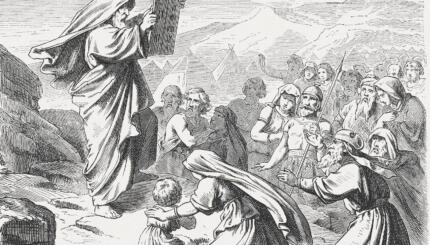Judaism’s profound appreciation for the human body has ancient beginnings: “The Lord God formed the human from the dust of the earth; He blew the breath of life into his nostrils, and the human became a living being,” the Torah recounts (Genesis 2:7). The body and soul have distinct origins, and the living human being needs both. The human body is many things in Judaism, first and foremost the repository of the soul.
Among the blessings the observant Jew says on rising in the morning are two related blessings, one regarding the human body and one regarding the human soul. The blessing regarding the body begins “Blessed are You who has created humanity in wisdom…” It then states, in quite vivid appreciation of human anatomy, that it is “well known that if any of [the bodily openings] that is to be open closes, or that is to be closed opens, we can not exist and stand before God.” The companion blessing, regarding the soul, declares that “The soul You have given me is pure. You preserve it within me and will reclaim it from me…”.
 In this sense, Judaism views the body the same way it does the soul: a human being is not the owner of his or her own body, but receives it from God to hold in trust. This has serious consequences and affects Judaism’s views towards abortion, suicide and euthanasia, which cannot be seen as purely private matters.
In this sense, Judaism views the body the same way it does the soul: a human being is not the owner of his or her own body, but receives it from God to hold in trust. This has serious consequences and affects Judaism’s views towards abortion, suicide and euthanasia, which cannot be seen as purely private matters.
The human body in Judaism–like food, money and sex–is in and of itself neutral with respect to sin. It does not carry the taint of “original” or innate sin, yet it can be an instrument of sin. The ancient rabbis taught that humanity was created with two yetsers (inclinations), the evil and the good. They viewed the “evil inclination” as something like the id in Freudian psychology, a driving force of physical needs/desires that can trip a person up, yet also provides the life force necessary for human society.
The essence of Judaism’s approach is to channel, not repress, such physical needs and pleasures, and to keep them within defined bounds. Sexual activity between husband and wife is not only permitted but indeed commanded and intended for mutual pleasure, with restrictions in connection with the woman’s menstrual cycle.
Bodily impurity in traditional Judaism–whether from menstruation, the emission of semen or contact with a dead body–is only of temporary duration and is resolved through rituals of purification.
Jews have long prayed for physical health as a prerequisite for a good life, along with “fear of heaven and fear of sin,” but Jewish culture has never particularly exalted the muscular, toned body. In the Diaspora, where the military and organized sports were often important parts of the host culture, Jews gave priority to study, both of Torah in the yeshivot (institutions of traditional Jewish learning) and of the academically-demanding professions open to them.
Still, Jewish farmers and city dwellers of various periods engaged in much more physical activity than many contemporary individuals in our increasingly sedentary society. And some Zionist writings emphasized images of physically invigorated, fit pioneers, a cultural image which gained potency in light of near universal service in the Israeli army and the physical return to the land.
Physical beauty has often been a vague concept in Jewish writings. A handful of biblical characters are described as “good looking,” but no particular attributes are ascribed to them. Personal qualities are given higher priority, as in the biblical story of Ruth in which the central characters display admirable human traits like generosity and loyalty. This emphasis on inner characteristics reaches theological proportions in I Samuel 16:7 where God tells Samuel: “A person looks at outward appearance, but the Lord looks at the heart.”
The human body itself has an essential and specific role in the fulfillment of several important commandments—for example, wearing tefillin (phylacteries) on the head and arm, or sitting in a sukkah. Most remarkable is brit milah, the ceremony of ritual circumcision first commanded to Abraham (Genesis 17:10).
Circumcision has remained the most widely observed of Jewish practices by Jews worldwide–even in the most trying of circumstances, such as during the Holocaust. In the Torah, God calls this physical act on the body–on an organ so fraught with associations of responsibility and irresponsibility, good and bad human behavior–“My covenant between Me and you and your offspring to follow”–perhaps one important indication of the significance of the body in Judaism.
Torah
Pronunced: TORE-uh, Origin: Hebrew, the Five Books of Moses.



